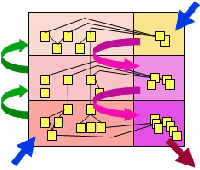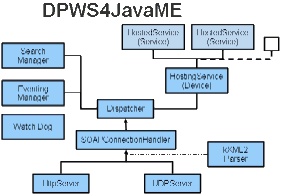


Quantitative Models: Specification and Analysis
Discrete Optimization under Uncertainty
Simulation and Optimization Methods to support Industrial Adaption Processes
Structured Analysis of Large Data Sets and High-Dimensional Data
Computer Networks and Distributed Systems
Traditionally the main interest of Informatik IV is in a methodology and techniques for the performance evaluation (PE) of computer and communication systems as well as logistics networks. More recently, research in the field of optimization has been performed, considering uncertainties as well as time-critical real-time control of factory areas.
Stochastic discrete-event models are often used to analyse the performance of systems. The specification of such a model includes the description of its (discrete) state space and the (possibly stochastic) rules of its state transitions. Common techniques for analyzing such models (and thus for system evaluation) come from categories that are characterized as "algebraic", "numerical" and "simulative". Numerous research activities have been and still are heading towards a broad support of the specification and analysis of corresponding models, such as the consideration of correlations in the specification of arrival and service processes or the calculation of bounds to determine guarantees in service level agreements. These research activities often result in specific tool support, e.g. the ProFiDo toolkit (Processes Fitting Toolkit Dortmund), which supports a variety of procedures for fitting and modeling arrival processes, or the SLA tool, which supports the efficient calculation of bounds in hierarchical systems for typical quantitative measures such as response times and service capacities.
During the development and operation of technical systems, numerous configuration and design decisions have to be made so that the required services are rendered in the most resource-efficient and cost-effective manner. These decisions are based on the solution of discrete or mixed discrete-continuous optimization problems, which are often difficult to solve, because in the course of the "combinatorial explosion" the number of alternative solutions increases exponentially with the number of decisions between discrete alternatives. Many practical problems are therefore considerably simplified in order to make them accessible to an algorithmic solution. Furthermore, real decisions usually have to be made on the basis of incomplete knowledge. The resulting uncertainty is usually not taken into account in today's optimization approaches, although this might lead to significant deviations between the solution found and the real optimum. Our research activities include numerical models, e.g. Markov Decisions Processes (MDPs), whose parameters, in contrast to the classical specification, are not fixed, but are described by discrete or continuous probability distributions.
In a changing business environment, the demands on the adaptability of factories are growing. The shortest possible time to make the necessary adjustments is crucial for the company's competitiveness. Nowadays, the adaption process is often supported by model-based examinations and has to take real-time data into account for a valid evaluation. By means of simulation and prediction techniques, characteristics of the future system behavior can be derived, which are included in appropriate optimization methods for determining a factory configuration that is well adapted to environmental changes. Practicability and robustness of the optimization results can in turn be evaluated using simulation models.
Nowadays, in many application areas immense amounts of data is generated and collected. This data helps to understand, evaluate and control systems. In order to obtain the necessary information from the data, it has to be saved, analyzed and modeled, which requires new data structures and algorithms. Our research activities consider the analysis of large structured stochastic models and the evaluation of high-dimensional simulation data. The methods are based on special data structures, such as hierarchical Kronecker representations, tensor trains or Tucker decompositions, in order to store high-dimensional structures compactly without losing too much information. Based on such compact data structures we develop numerical algorithms for an efficient analysis.
Modern computer networks combine worldwide communication facilities with local information bases and processing functions in order to support powerful distributed application systems. Central topics of our practical research work are the logical architectures of applications, underlying computer networks, and telecommunication systems as well as suitable hard/software structures for their implementation. In this context, we study the application of formal methods for the functional modelling and specification of event-discrete systems. Tools are provided supporting the computer-assisted productive development of high-quality systems.
With respect to the modelling by extended communicating finite state machines, reachability graph based analysis tools are applied in the development process of communication software. So, in cooperation with a manufacturer of communication systems, a logical protocol stack has been analysed and its high-performance implementation combining activity-thread and server architectures has been verified.
With respect to more general state transition system models, the TLA-project resorts to L. Lamport's approach 'Temporal Logic of Actions'. Construction tools (e.g., syntax-directed editor, browser, parser, interpreter, visualisation and animation) and verification tools (e.g., frontends to predicate logic theorem provers, on-the-fly model checker for safety and liveness properties) are under study. At present they are adapted to a compositional TLA specification style which supports the modular description and decompositional verification of process systems. Currently the style is used for the modelling of flexible application-driven configurations of high-speed transfer protocols. Secondly, an approach for the tool-assisted construction of distributed applications is based on the style.
Our research focuses on:
|
|
network protocols:
specification, verification, and efficient implementation,
distributed applications:
configuration and management of distributed applications,
integrated network and system management:
policy- and model-based automation of technical management tasks,
security of networks and distributed systems:
automated security management.
Recent developments enclose the modular formal specification technique cTLA, a technique translating state-machine-models to efficient implementations of network protocols, control wrappers interacting with trust information services in order to secure component-structured applications, the approach of object-oriented security analysis, the automated management approach model-based management (MBM), and the Web Services server implementation Java Multi Edition DPWS Stack (JMEDS).
 |
|
The MBM approach is an extension of the so-called policy-based technical network, system and application management. MBM provides the refinement of abstract high-level policy definitions into configuration descriptions and executable management rules. Its application is supported by the tool MoBaSeC (model-based service configuration) and a run-time management system. The tool performs the interactive graphical modelling of management policies and system structures. Moreover, it translates representations of abstract policies into low-level policies which are automatically enforced by the management system at runtime. The MBM approach has successfully been applied for the configuration of security services and protection mechanisms of networked systems as well as for the technical management of distributed service systems including general configuration, fault, performance, security and account management.
|
|
 |
The JMEDS DPWS server implementation supports the light-weight implementation of service systems by means of resource-restricted devices and embedded systems. The implementation is Java-based and suitable for the Micro Java Edition. It is compliant with the OASIS standard Devices Profile for Web Services (DPWS).
MBM and JMEDS have been developed in close cooperation together with the industrial partner MATERNA, Dortmund. Both approaches will be applied in the project OSAMI, where JMEDS will be adapted to OSGi environments and support the interactions between distributed devices. MBM will form the basis of policy-controlled self-management functions which will support the adaptation of device-based service systems to changing conditions, user needs and environments.